Featured photo: Earl Gardner
Editor’s note: This post is part of PSP’s 2018 Season Review series, in which PSP breaks down the season that was and look at the off-season ahead. To read the full series, click here.
It’s report card day.
We’re handing out grades for Union players today, and lest you wonder, none of the young players get graded on a curve due to age, only on performance.
Check out the grades and let us know what you think in the Comments section below.
Goalkeepers
Andre Blake: B+
Blake had a very good and very busy season as a shot-stopper in the run of play, although he tailed off after a September illness. Blake’s distribution has gradually and consistently improved, and he has become quite good coming off his line, something particularly important to a team that plays a high line like the Union do. On penalty kicks, however, he cemented a reputation for being unable to stop pretty much any of them, whereas his counterparts among the league’s top goalkeepers (Zack Steffen, Tim Melia, and of course the PK destroyer, Nick Rimando) are proving elite on PKs. Still, Blake looks plenty good enough to play in a quality league in Europe, probably the league’s best shot-stopper in the run of play.
Some stats to add perspective:
Only one team saved more shots inside the penalty area than the Union’s 82. No playoff team saw its goalkeeper make more saves than the Union’s 125. (Only Minnesota, Montreal and Colorado had more league-wide.)
John McCarthy: B+
McCarthy started one game for the Union, and he played so well that it made him, statistically, the top ranked player in all of MLS by WhoScored.com, if you don’t factor in games played. He also recorded four clean sheets and a 75% save rate in 12 USL games for Bethlehem Steel. Nobody’s claiming he’s truly the league’s best, but he has shown over time that he has what it takes to be a starting goalkeeper in MLS. If Blake leaves for Europe, the local boy backing him up may inherit the job by merit.
Jake McGuire: n/a
McGuire had a respectable season for Bethlehem Steel, saving 71% of the shots he faced and recording five clean sheets in 23 starts. He never appeared in a game for Philadelphia.
Defenders
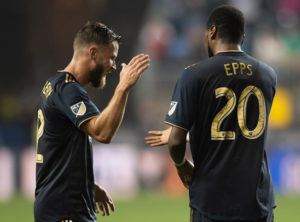
Keegan Rosenberry returned to form this year, while Marcus Epps briefly impressed before disappearing. (Photo: Earl Gardner)
Keegan Rosenberry: B
Rosenberry returned to form after a messy sophomore season. He was excellent in distribution, and the Union possession game became one of the league’s best in part because Rosenberry effectively functioned like an auxiliary midfielder. When paired with Ilsinho on the right wing, Rosenberry was excellent on the overlap, connecting 16 of 67 crosses but also finding his partner in space toward the end line. He ranked 13th among MLS fullbacks in key passes, but that may be more a function of his team’s problems at striker and right winger. Defensively, he was generally solid, but his lack of speed sometimes left him vulnerable to speedy wingers.
Olivier Mbaizo: B
Mbaizo showed he has MLS quality during his one MLS start. He featured mostly for Bethlehem Steel after returning from injury, and in USL, his athleticism sometimes made opponents look awfully foolish. He looks like a very good signing for Philadelphia.
Ray Gaddis: C+
Gaddis faded down the stretch after getting hurt in September, which probably indicates he felt the lingering effects of that injury. Up to that point, he was excellent defensively and offered much more going forward than he historically has when deployed on the left side. He still remains a very right-footed player, which renders him nearly irrelevant as an overlapping and crossing threat, but he surprised opponents on a number of occasions by flying up into attack in useful ways. On the whole, it was a good season for Gaddis once again playing a position that is unnatural for him. He’s not the long-term answer at left back, but the classic team player filled in ably when needed, starting 26 games and breaking the team record for most minutes played with the Union in a career.
Fabinho: C
Fabinho played only 11 regular season games, starting 8, the fewest in his MLS career. The Brazilian was generally effective as a spot starter and backup and proved a solid reserve for the club. This is the best role for Fabinho at this point in his career. If he returns for another season, it will probably be in this role and as a mentor to Brazilian-American left back Matt Real, who projects as the Union’s left back of the future — and 2019.
Matt Real: C-/B+
Speaking of Real, he’s going to get a split grade here. With the Union, he wasn’t quite up to par in his three games, but he’s just a teenager, so it’s to be expected. His second grade covers the rest of his year, because he had a solid season with Bethlehem and by November was captaining the U.S. U20 Men’s National Team. The Union will give him every opportunity to win the starting left back job in training camp next year, and with Auston Trusty now a known quantity, the coaching staff may be more willing to risk starting Real for an extended period.
Mark McKenzie: B
McKenzie is not being graded on the curve here. He truly was an above average MLS center back this season, making MLS Team of the Week multiple times. He demonstrated excellent recovering speed, good positioning, and ball-handling and short passing ability that bordered on elite for an MLS center back. He still lacks experience, and his share of mistakes demonstrated that. But the way he plays the game excites quite a few, and his style of play (though not his age) made him a perfect partner for Auston Trusty.
Jack Elliott: B
Like McKenzie, Elliott had a solid year, and both put in above average seasons that likely put each in demand around the league. On the whole, he was probably marginally steadier than McKenzie in defense, with whom he split time at right center back, though he got exposed a few times for lack of foot speed. He offered much more in the air and on set pieces than McKenzie, even netting a brace against New England in August.
Auston Trusty: B
Again, we’re not grading on the curve because Trusty was a teenager. Had he been eligible for the Rookie of the Year award, he would have won it. He played every minute in MLS games for the Union, and for most of the year, he was excellent. He was very good in the air, physical against opponents, and showed recovery speed that is rare for center backs of his size. His short passing was typically clean, but he showed a tendency to, when he couldn’t find someone fairly quickly, simply boot the ball long, well past the left-sided winger. The biggest drawback for Trusty was that, by season’s end, he looked mentally burnt out, and the mental errors piled up, notably two own goals in key games down the stretch.
Richie Marquez: n/a
It was a lost season for the former Union starting center back. He lost a training camp battle against Auston Trusty, and injury wiped out much of the rest of his season. He never saw the field in a regular season game, played just four games for Bethlehem Steel in USL, and enters the off-season likely looking for a way out of Philadelphia and to one of the many teams around MLS that could use a starting center back of his caliber.
Josh Yaro: n/a
Yaro never saw the field for Philadelphia and played just six matches for Bethlehem Steel. His once promising but ultimately injury-plagued Union career looks like it is finished.
Midfielders
Haris Medunjanin: B
Medunjanin pushed further toward extremes this year. His passing was even more impressive as it helped create one of the league’s best possession games. His 62 key passes ranked 15th overall in MLS and third overall among players who do not play attacking midfielder. On the other hand, his defensive flaws were even more apparent as opponents sought to exploit him and routinely killed the Union on the counterattack. Medunjanin is an Andrea Pirlo-like player for the Union. Their possession game starts with him, and he is the first player opponents try to shut down on offense and exploit on defense. It made him a very unique component of the Union lineup all year.
Alejandro Bedoya: A-
Bedoya did everything the Union asked of him this year. He was among the league’s best passers in midfield, covered defensively for teammates’ defensive inequities, and offered excellent combination play in attack down the right side when he pushed forward. He was the ultimate glue player, and while some might not want that from a Designated Player, one should absolutely want that from a No. 8 center midfielder.
Warren Creavalle: C+
Crevalle fared well as a late game defensive reserve and spot starter, and he has firmly settled in as a key role player on the team, the team’s first center midfielder off the bench. What he lacks in passing judgment at times, he makes up for in defensive coverage.
Derrick Jones: C+
Jones had games where he looked like he was everywhere, and then he had moments where he’d lose the ball in traffic and make a poor pass, and you’d wonder what on earth he was thinking. As the season progressed, he showed better and won back Jim Curtin’s trust — to a degree. Jones still isn’t fully trusted by the technical staff, but he’s getting there. Unfortunately, he still hasn’t shown whether he is a No. 8 or a No. 6, and while that not matter if you say he’s just a good soccer player, it does matter if it prevents him from getting on the field. He has plenty of talent, but he has something to prove going into next season.
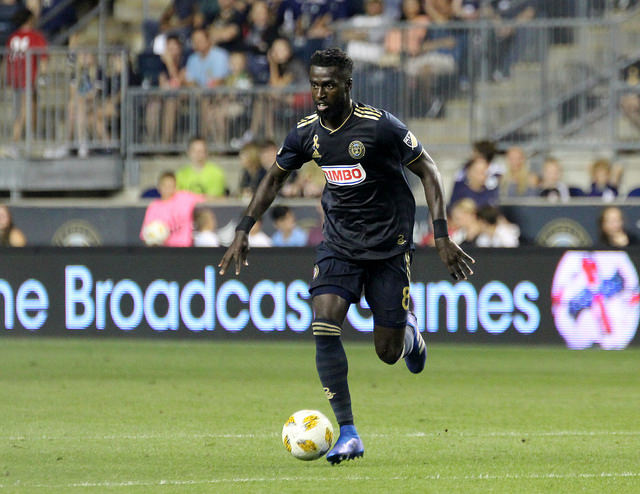
Derrick Jones impressed in youth national team duty and cracked through again to win minutes as a reserve for Philadelphia. (Photo: Paul Rudderow)
Borek Dockal: A
Dockal keyed the Union attack after acclimating to the club, and his presence made the Union a different team. He led MLS in assists (18), ranked sixth in key passes (89) and added 5 goals. His intensity was infectious among his teammates. Defensively, he was generally better than expected, though he doesn’t match predecessor Tranquillo Barnetta in that department. Overall, a fantastic season.
Adam Najem: n/a
Najem never appeared in a game this year for Philadelphia, while recording 3 goals, 2 assists, and 34 key passes in 15 games for Bethlehem. He too will be looking for greener pastures elsewhere, because it’s clear the 23-year-old won’t be getting a crack at the Union lineup anytime soon.
Anthony Fontana: C
Fontana scored in his first career MLS match to open the season, and it looked like great things were in store. He soon fell out of the Union rotation, however, and played only 15 games for Bethlehem Steel. Like Jones, he looked like a positional tweener, not quite a No. 10 and not quite a No. 8, and that likely hurt the 19-year-old local product, because it meant he wasn’t the preferred backup for Dockal as the season progressed.
Ilsinho: B-
When healthy and fresh, Ilsinho was dominant off the bench. He cracked open bunkered defenses with his dribbling skill, opened the overlap for right back Keegan Rosenberry, and created danger all over, netting 6 goals, 3 assists and 22 key passes in just 1,031 minutes. However, therein lies the problem: He played just 1,031 minutes. He missed 10 games and the U.S. Open Cup final due to injury. When he wasn’t hurt, he was often working back to full fitness, and he never looked 90-minutes fit all year. Ilsinho must do the off-season work to keep his weight down and stay fit next year, because when fit and fresh, he is one of the league’s most uniquely dazzling, dangerous and enjoyable players.
David Accam: F
Accam was the Union’s big off-season acquisition. He proved to be the league’s biggest off-season bust instead. After recording 33 goals and 15 assists the prior three seasons in Chicago, he scored just one goal and justifiably lost his starting job to Fafa Picault before hernia surgery ended his season in October. He looked like a one-trick pony whose only trick was to go one on one with defenders, but his burst was lacking. Given his lack of involvement in the Union’s possession game, that meant a lot, and his defensive effort was generally weak in comparison to his competitors. It’s possible injury was hampering him earlier than outsiders recognized, but we can only grade based on what we know, and what we know is that he underperformed.
Fabian Herbers: C
Once again, Herbers suffered some nagging injuries this season. When he played, he was solid enough but unspectacular, failing to impress enough to lock down a starting job. His best moments came when he got into interesting attacking positions in the center of the field, but those were rare because Curtin deploys him most regularly as a right winger. In 15 USL games for Bethlehem, he scored 5 goals and handed out 4 assists and 16 key passes, and he looked very intriguing when Bethlehem head coach Brendan Burke deployed him as a striker.
Marcus Epps: C-
Epps had one great game in his first start of the season for the Union, with a goal and two assists, but after that, it was diminishing returns until he lost the starting spot and never again featured for the Union. He played 15 games for Bethlehem, and despite some explosive moments, it seems that USL (or another team) is where Curtin sees his future. It was a disappointing season after a promising start.
Fafa Picault: B+
Picault was excellent for the Union, not only netting 10 goals and 5 assists, but contributing to the possession game and hustling on defense. Nothing illustrated this better than his late game interception of a pass and subsequent game-winning goal in Seattle when the Union had gone down a man. His intensity and complete lack of fear set a tone for the Union. Picault earned a return to the U.S. National Team, and he cemented a spot as one of the team’s core and most important players.
Strikers
C.J. Sapong: D
No player in the league attempted more aerial duels than Sapong (236). That counts for something. Unfortunately, Sapong didn’t score goals, and that’s what the Union needed from their starting striker after his 16-goal 2017 season earned him a contract extension. Sapong lost his scoring confidence early on and never got it back, often looking uncomfortable when getting the ball anywhere near shooting position. It was a devastating collapse, particularly given how hard he works defensively and with his hold-up play. He salvaged his season by maintaining a starting spot on the right wing, but he showed that he’s still a striker out of position there. Perhaps it was fatigue after last year’s performance earned him U.S. national team time during the off-season. Perhaps not.
Cory Burke: B-
Burke surprised everyone who hadn’t been watching him in USL or Jamaica. He was lively as a reserve early on, and when Sapong fell away, Burke seized the starting role by being repeatedly dangerous around goal, scoring 11 goals in just 1,520 minutes. His first start hinted at what would come, when he scored a goal and got red carded in the same game. From that point on, he was always a threat to do both. He ranked second in the league in fouls per 90 minutes among players who played more than 900 minutes, just a fraction behind New York City midfielder Yangel Herrera. Burke’s lack of control cost him minutes, because he was often a threat to send his team down to 10 men. Between the ill discipline and average at best holdup play, the new car shine had begun to wear off by season’s end.
Jay Simpson: ???
How do you grade Jay Simpson? He’s a well-paid striker who couldn’t win a starting job on a team that really needed a quality striker. When he finally got the chance to play in 2018, his performance was so miraculously clutch and spectacular that he won MLS Player of the Week and helped the Union collect perhaps the two most improbable wins of their nine-year existence. But oh, that salary…
Kacper Przylblko: n/a
The late season signing never played a game for the Union.
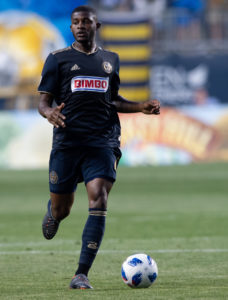
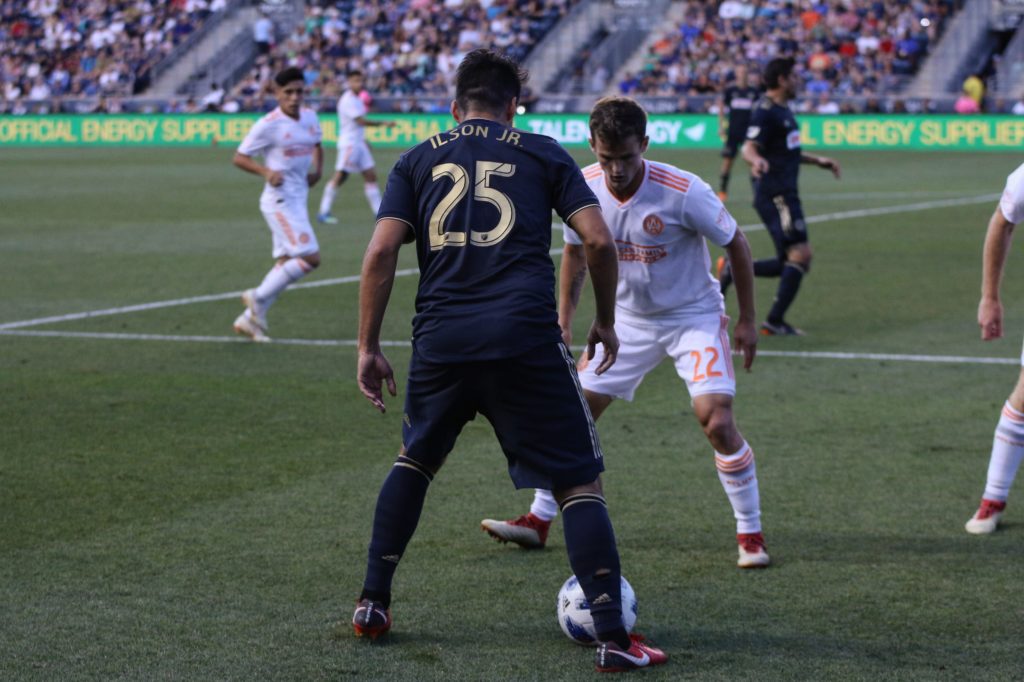
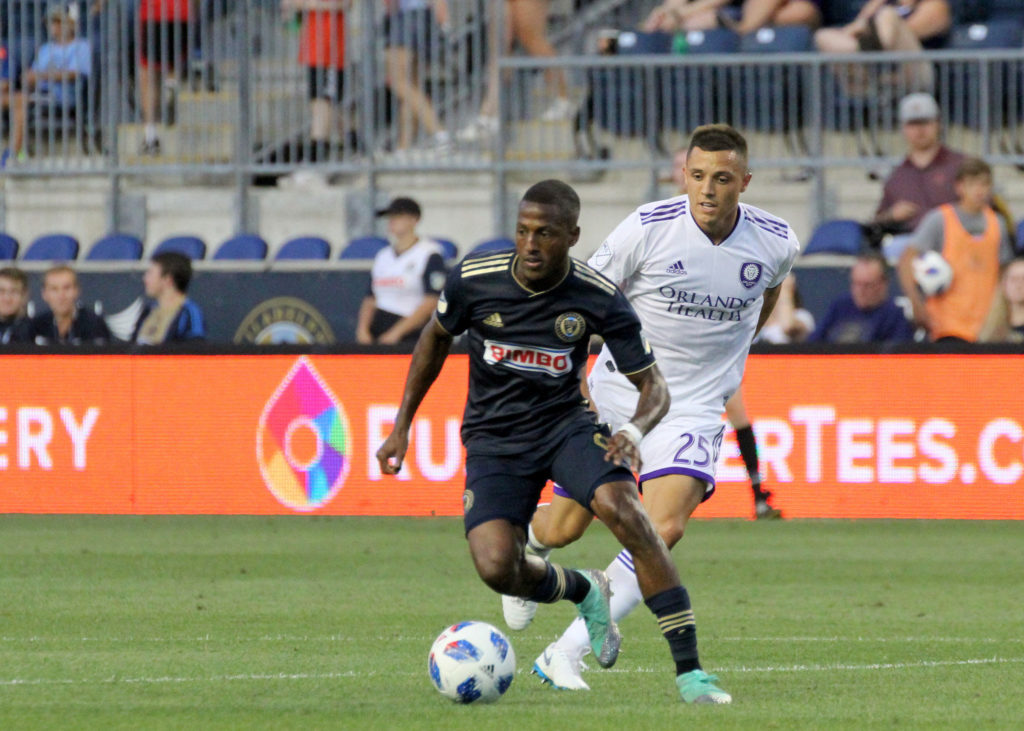
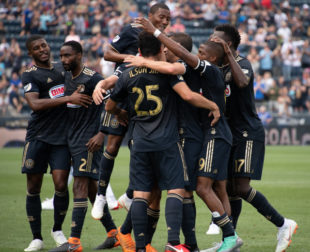

The #1 need on this team is a rich business partner.Doakal is must sign and key to the offense Burke Fafa and Bedoya. Are also must haves. A Dax Macarthy. and Brandon Vincent equivalants to replace Medujian who has slowed down to a fast jog and is no help. against any. fast team,that counter attacks through the middle. Gaddis can not create from the back and is just a journey man type left back. They need to improve,here also.
They should be able to pick up a better more creative left back like Vincent through the draft. They need to not miss on Accams
1replacement. They also need a feature DP striker who is a real threat. Unfortunately they have an owner with no money.
I had big hopes for Accam. He has single-handedly killed teams that didn’t respect his skills. I do think his (groin?) injury held him back – or Curtin couldn’t figure out how to unlock him.
.
On the one hand I want to see him on the team next year, but on the other hand Fafa needs to be on the left and has a bigger upside while providing the same results Accam would have. Since Accam didn’t look that good on the right (maybe for the same reasons as above) I’m not sure it’s worth the cap hit to keep him.
.
Granted he’ll move on to another team, get healthy, and kill the Union when they play again….
In re: goalkeepers.
.
Jake McGuire by inference, was on permanent unrecallable loan to USL all season. There is an extreme hardship exception for goal keepers that would have allowed him to be called up had someone been unavailable.
How do you not give McCarthy an A?
You clearly graded Trusty on a curve. If he were not the Academy poster child, he would have been benched many times throughout the year.
His clinical finishing of own goals is a sight to behold. He is unstoppable at his own net.
Disagree. Until the end, he was excellent.
I think most of these grades are pretty fair, but my one big disagreement would be with Medunjanin whom I would give a C. I think he was more of a liability than an asset this season. He would make about one really nice pass every match, but I think this was overshadowed by his slow speed getting back and his overall poor defense (not to mention some displays of poor passing during some matches). He’s the guy I really think the club needs to move on from, but they’ve already picked up his option for next year, so I fear we may be in for more of his limitations shielding our young back line…
After 9 years of poor to mediocre results from this team, it is time for you to grade the team management and owner.
So if Medujanin is back next season, he’s the equivalent to Pirlo in the sense of how he should be implemented on the field. He’s not a D mid what so ever. So we need a D mid on the field next year( Creavalle or jones)?? And, if we lose Dockal who knows what our central midfield will look like…..
If he’s not a D-mid, then either… 1) You play him next to a real D-mid (like Jones), in which case you have no room for Bedoya in his roaming glue-type role; or 2) You play him next to Bedoya as we did this year and have no real D-mid.
–
I consider both of those options unacceptable. Leading me to option 3: We play a real D-mid next to Bedoya, and put Medunjanin on the bench.
–
Since he’s already signed, his best role might be as basically the backup playmaker; not to play the #10, but if our starting #10 (Dockal??) gets hurt, maybe we push Bedoya up and retool the offense to run through him in a deeper position.